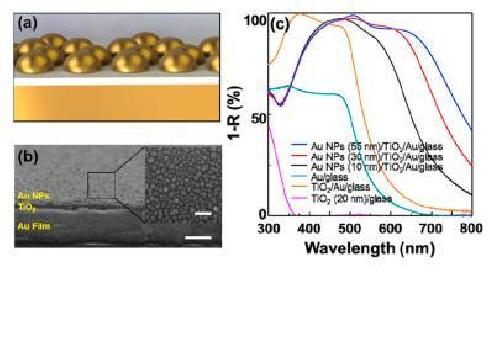A team of Korean researchers, affiliated with UNIST has recently pioneered in developing a new type of multilayered (Au NPs/TiO2/Au) photoelectrode that boosts the ability of solar water-splitting to produce hydrogen. According to the research team, this special photoelectrode, inspired by the way plants convert sunlight into energy is capable of absorbing visible light from the sun, and then using it to split water molecules (H2O) into hydrogen and oxygen.
This study is a collaboration among scientists, including Prof. Jeong Min Baik (School of Materials Science and Engineering, UNIST), Prof. Jae Sung Lee (School of Energy and Chemical Engineering, UNIST), Prof. Heon Lee (School of Materials Science and Engineering, Korea University), and Prof. Jonghwa Shin (Department of Materials Science and Engineering, Korea Advanced Institute of Science and Technology).
This multilayered photoelectrode takes the form of two-dimensional hybrid metal-dielectric structure, which mainly consists of three layers of gold (Au) film, ultrathin TiO2 layer (20 nm), and gold nanoparticles (Au NPs). In a study, reported in the January 21, 2016 issue of Nano Energy, the team reported that this promising photoelectrode shows high light absorption of about 90% in the visible range 380-700 nm, as well as significant enhancement in photo-catalytic applications.
 Two-dimensional metastructured film with Titanium Oxide is fabricated as a photo-catalytic photoanode with exceptional visible light absorption. Credit: UNIST
Two-dimensional metastructured film with Titanium Oxide is fabricated as a photo-catalytic photoanode with exceptional visible light absorption. Credit: UNIST
Many structural designs, such as hierarchical and branched assemblies of nanoscale materials have been suggested to increase the UV-visible absorption and to enhance water-splitting efficiency. However, through incorporation of plasmonic metal nanoparticles (i.e. Au) to TiO2 structures, their photoelectrodes have shown to enhance the photoactivity in the entire UV-visible region of solar spectrum when compared to the existing ones, the team reports.
Prof. Jeong Min Baik of UNIST (School of Materials Science and Engineering) states, "Several attemps have been made to use UV-based photoelectrodes for hydrogen production, but this is the first time to use the metal-dielectric hybrid-structured film with TiO2 for oxygen production." Moreover, according to Prof. Baik, this special type of photoelectrode uses approximately 95% of the visible spectrum of sunlight, which makes up a substantial portion (40%) of full sunlight. He adds, "The developed technology is expected to improve hydrogen production efficiency."
Prof. Heon Lee (Korean University) states, "This metal-dielectric hybrid-structured film is expected to further reduce the overall cost of producing hydrogen, as it doesn't require complex operation processes." He continues by saying, "Using nanoimprint lithography, mass production of hydrogen will be soon possible."
Prof. Baik adds, "This simple system may serve as an efficient platform for solar energy conversion, utilizing the whole UV-visible range of solar spectrum based on two-dimensional plasmonic photoelectrodes."
This work was supported by the Pioneer Center Program through the National Research Foundation of Korea (NRF) grant, funded by the Korean government (MSIP). It has been also equivalently funded by the 2014 Research Fund of UNIST (Ulsan National Institute of Science and Technology), as well as by the KIST-UNIST partnership program.
source: Ulsan National Institute of Science and Technology(UNIST)